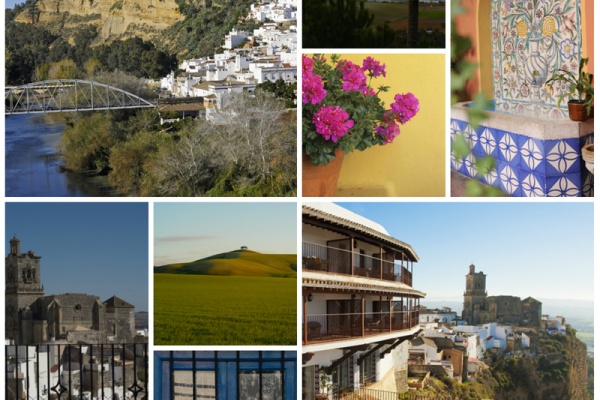
The parish church of Santa María de la Asunción dominates the Plaza del Cabildo © Michelle Chaplow |
|
Things to See in Arcos de La frontera
A selection of the main sites in Arcos de la frontera. Many are included in a Ruta Monumental (Monuments Route). Pick up a leaflet at the tourist office.
Plaza del Cabildo
This is the best place to head for to start your tour of Arcos. This square which serves as a car park is bordered by Town Hall, Castle and Music Conservatory, Church of San Pedro, Parador Hotel, Mirador Viewpoint.
The castle was first constructed in the 11th century by the Moors when Arcos was briefly a taifa (small kingdom) before being captured by the Christians in 1250. The Christians rebuilt the castle as part of their campaign to retain their hold on the town, which was in a strategically important position for maintaining the border between the Muslim and Christian kingdoms.
The town's suffix de la Frontera (of the frontier) was added at this time and denotes this struggle for territory. Following the Christian conquest the castle became the home of the Duke of Arcos. The castle is now privately owned and is not open to the public.
The image below left was taken through the heart shaped wrought iron windows of the Parador Hotel.
Parador Hotel
Once a palace, the “Casa del Corregidor” Parador Hotel. is located in a three-sided plaza along with the Ducal Castle and the Santa María church. While on one side the Parador rooms look out over the orange trees that fill this square, on the other side, guests enjoy sweeping views from the cliffs that drop dramatically to the Guadalete River.
Iglesia de Santa María de la Asunción
The parish church of Santa María de la Asunción dominates the Plaza del Cabildo. Its southern façade is topped by an ornate 18th-century Baroque belfry, but the highlight is the finely carved Plateresque doorway on the west side. Constructed on the site of a mosque, the church interior is well worth visiting for its exquisitely ornate Baroque choir stalls, carved in mahogany, ebony and cedar by Diego Roldán, magnificent vaulting, a lavish Renaissance altarpiece and an interesting mural. More info
Iglesia de San Pedro
If you follow the streets adjacent to the Parador Hotel, also on the same square, you arrive at another impressive church, the 16th-century Iglesia de San Pedro, perched in a perilous cliffhanger of a position. Inside is a gilded altarpiece detailing the life of San Pedro and paintings attributed to Francisco de Zubarán.
Palacio de Mayorazgo
One of Arcos’s finest Renaissance buildings is the grand Palacio de Mayorazgo opposite the Iglesia de San Pedro. It has a richly decorated exterior façade in the style of the architect Herrera and beautiful interior patios, and is now used as an OAP social centre. Visiting times are Monday to Saturday 10.00-14.00 and 17.00-20.00, Sundays 11.00-14.00.
Convento de la Encarnación
In the central thoroughfare of Callejón de las Monjas - a continuation of Cuesta Belén - is the 16th-century Convento de la Encarnación, which served as a chapel and a hospital before being converted into a convent. It has a remarkable Plateresque doorway.
Covento de Mercedarias Descalzas
Tucked away in the Plazuela de Botica number 2, which is very near to the Parador Hotel. Here you have an absolute treat the cloister nuns make hand made cakes and sweets, which are on sale to public. You need some level of Spanish as you place your order via a small wooden hatch with a turntable, you pass through the payment and your cakes and change will be returned via the hatch. They don´t see you and you don´t see them, the cakes are delicious. Don´t miss the Bodaditos de chocolate, naranja y almendras (dark chocolate, orange and almond cups). Every thing is very reasonably priced and they open from 8.30am until 14.30pm reopening after the Spanish siesta time from 5pm until 7pm.
Convento de la Caridad
Built in the late 18th-century, this colonial-style whitewashed convent on the Plaza de la Caridad has an ornate interior and is flanked by several attractive courtyards.
Hospital de San Juan de Dios
Near the Paseo de Andalucía is this former hospital dating from the 16th century. Within the hospital is a Baroque church with an unusual pine altarpiece, which features an impressive Gothic figure of Christ.
Iglesia de San Agustín
Founded in the early 16th century as a convent, this building became a monastery 50 years later, until the early 19th century when it was abandone. The church remained, however, and the 16th-century statue of Jesus is paraded about the streets on Good Friday.
JARDIN ANDALUSI
This is a modern small town garden in the Moorish style. The main feature is a small fountain and water trough. Some like this reconstructive architecture, others don’t. Worth crossing the street to take a closer look. Visiting times are Monday to Saturday 10.00-14.00 and 17.00-20.00, Sundays 11.00-14.00.
Palacio del Conde de Águila
On Calle Cuesta de Belén is this 15th-century ducal residence in gothic-mudéjar style with an elaborately carved stone façade.
Mirador de la PeÑa Nueva
The Mirador de la Peña Nueva on the open side of the Plaza del Cabildo offers stunning views over the rolling countryside to the west. There was a webcam, on the front of the Town Hall which points at the Mirador, ensuring that the watchers are also the watched.
Town Hall
The Town Hall has been in the Plaza del Cabildo since 1634. The tourist office is located here. Of interest is the stone doorway crowned by Archangel San Miguel, the patron saint of the town. Inside the Town Hall there is a painting of King Carlos III attributed to Goya. Visiting times are Monday to Friday, 10.00-13.30, reservations in the Tourist Office.












